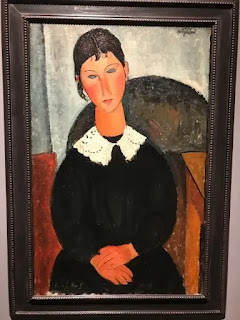Amedeo Modigliani
Italian artist
By The Editors of Encyclopaedia Britannica • Last Updated: Jul 8, 2022 • Edit History
Amedeo Modigliani
Born:
Died:
January 24, 1920 (aged 35) Paris France
Summary
Read a brief summary of this topic
Amedeo Modigliani, (born July 12, 1884, Livorno, Italy—died January 24, 1920, Paris, France), Italian painter and sculptor whose portraits and nudes—characterized by asymmetrical compositions, elongated figures, and a simple but monumental use of line—are among the most-important portraits of the 20th century.
Amedeo Modigliani: self-portrait
Self-portrait by Amedeo Modigliani, oil on canvas, 1919; in the Museum of Contemporary Art of the University of São Paulo, Brazil.
Courtesy of the Museu de Arte Contemporânea da Universidade de São Paulo, gift of Mr. Francisco Matarazzo Sobrinho and Mrs. Yolanda Penteado; photograph, Gerson Zanini
Modigliani was born into a Jewish family of merchants. As a child, he suffered from pleurisy and typhus, which prevented him from receiving a conventional education. In 1898 he began to study painting. After a brief stay in Florence in 1902, he continued his artistic studies in Venice, remaining there until the winter of 1906, when he left for Paris. His early admiration for Italian Renaissance painting—especially that of Siena—was to last throughout his life.
In Paris Modigliani became interested in the Post-Impressionist paintings of Paul Cézanne. His initial important contacts were with the poets André Salmon and Max Jacob, with the artist Pablo Picasso, and—in 1907—with Paul Alexandre, a friend of many avant-garde artists and the first to become interested in Modigliani and to buy his works. In 1908 the artist exhibited five or six paintings at the Salon des Indépendants.
In 1909 Modigliani met the Romanian sculptor Constantin Brancusi, on whose advice he seriously studied African sculpture. To prepare himself for creating his own sculpture, he intensified his graphic experiments. In his drawings Modigliani tried to give the function of limiting or enclosing volumes to his contours. In 1912 he exhibited at the Salon d’Automne eight stone heads whose elongated and simplified forms reflect the influence of African sculpture.
Modigliani, Amedeo: Head of a Woman
Head of a Woman, limestone sculpture by Amedeo Modigliani, 1910–11; in the National Gallery of Art, Washington, D.C.
Courtesy National Gallery of Art, Washington, D.C., (Chester Dale Collection and 1963.10.241)
Modigliani returned entirely to painting about 1915, but his experience as a sculptor had fundamental consequences for his painting style. The characteristics of Modigliani’s sculptured heads—long necks and noses, simplified features, and long oval faces—became typical of his paintings. He reduced and almost eliminated chiaroscuro (the use of gradations of light and shadow to achieve the illusion of three-dimensionality), and he achieved a sense of solidity with strong contours and the richness of juxtaposed colours.
The outbreak of World War I in 1914 increased the difficulties of Modigliani’s life. Alexandre and some of his other friends were at the front; his paintings did not sell; and his already delicate health was deteriorating because of his poverty, feverish work ethic, and abuse of alcohol and drugs. He was in the midst of a troubled affair with the South African poet Beatrice Hastings, with whom he lived for two years (1914–16). He was assisted, however, by the art dealer Paul Guillaume and especially by the Polish poet Leopold Zborowski, who bought or helped him to sell a few paintings and drawings.
Modigliani was not a professional portraitist; for him the portrait was only an occasion to isolate a figure as a kind of sculptural relief through firm and expressive contour drawing. He painted his friends, usually personalities of the Parisian artistic and literary world (such as the artists Juan Gris and Jacques Lipchitz, the writer and artist Jean Cocteau, and the poet Max Jacob), but he also portrayed unknown people, including models, servants, and girls from the neighbourhood. In 1917 he began painting a series of about 30 large female nudes that, with their warm, glowing colours and sensuous, rounded forms, are among his best works. In December of that year Berthe Weill organized a solo show for him in her gallery, but the police judged the nudes indecent and had them removed.
Alice, oil on canvas by Amedeo Modigliani, c. 1918; in the National Gallery of Denmark, Copenhagen.
Statens Museum for Kunst (National Gallery of Denmark); www.smk.dk (Public domain)
In 1917 Modigliani began a love affair with the young painter Jeanne Hébuterne, with whom he went to live on the Côte d’Azur. Their daughter, Jeanne, was born in November 1918. His painting became increasingly refined in line and delicate in colour. A more-tranquil life and the climate of the Mediterranean, however, did not restore the artist’s undermined health. After returning to Paris in May 1919, he became ill in January 1920, and 10 days later he died of tubercular meningitis. The next day Hébuterne killed herself and their unborn child by jumping from a window.
Little known outside avant-garde Parisian circles, Modigliani had seldom participated in official exhibitions. Fame came after his death, with a solo exhibition at the Bernheim-Jeune Gallery in 1922 and later with a biography by Salmon. For decades critical evaluations of Modigliani’s work were overshadowed by the dramatic story of his tragic life, but he is now acknowledged as one of the most significant and original artists of his time.
This article was most recently revised and updated by Naomi Blumberg.
With affection
Ruben


















No comments:
Post a Comment